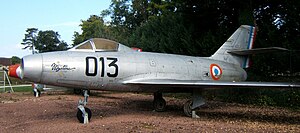Dassault Mystere
| MD.452 Mystère | |
|---|---|
 |
|
| Role | Fighter-bomber |
| Manufacturer | Dassault Aviation |
| First flight | 23 February 1951 |
| Introduction | 1954 |
| Retired | 1963 (France) |
| Status | Retired |
| Primary user | French Air Force |
| Produced | 1951–57 |
| Number built | 171 |
| Variants |
Dassault Mystère IV Dassault Super Mystère |
The Dassault MD.452 Mystère is a 1950s French fighter-bomber.
After the success of the Ouragan, Dassault was working on a more advanced machine based on it, which would take to the air in early 1951 as the MD.452 Mystère I.
The first prototype Mystère I was essentially an Ouragan with a 30-degree swept wing and modified tail surfaces. Two further prototypes followed, powered by the Rolls-Royce Tay 250 centrifugal-flow turbojet, an improved version of the Rolls-Royce Nene, built under license by Hispano-Suiza, and rated at 28.0 kN (6,300 lbf) thrust.
These three Mystère I prototypes led to two Mystère IIA prototypes, powered by the Tay and armed with four 20 mm (0.787 in) Hispano cannon; and then four Mystère IIB prototypes, which traded the four 20 mm (0.787 in) cannon for two 30 mm (1.181 in) DEFA revolver-type cannon. A Mystère IIA was the first French aircraft to break Mach 1 in controlled flight (in a dive), on 28 October 1951.
The eleven preproduction machines that followed were designated Mystère IIC, nine of which were fitted with the SNECMA Atar 101C axial-flow turbojet, rated at 24.5 kN (5,500 lbf) thrust, while two were experimentally fitted with the afterburning Atar 101F, with an afterburning thrust of 37.3 kN (8,400 lbf).
The French Air Force ordered 150 Mystère IICs, with the first production machine flying in June 1954, being delivered in October of that year. The production aircraft featured the twin 30 mm (1.181 in) DEFA cannon, an Atar 101D turbojet with 29.4 kN (6,600 lbf) thrust, increased tail sweep, and revised intake trunking and internal fuel tank arrangement. Top speed was 1,030 km/h (560 kn; 640 mph) at low level. Details of external stores are unclear, but a reasonable assumption would be that they were similar to those of the Ouragan.
...
Wikipedia
